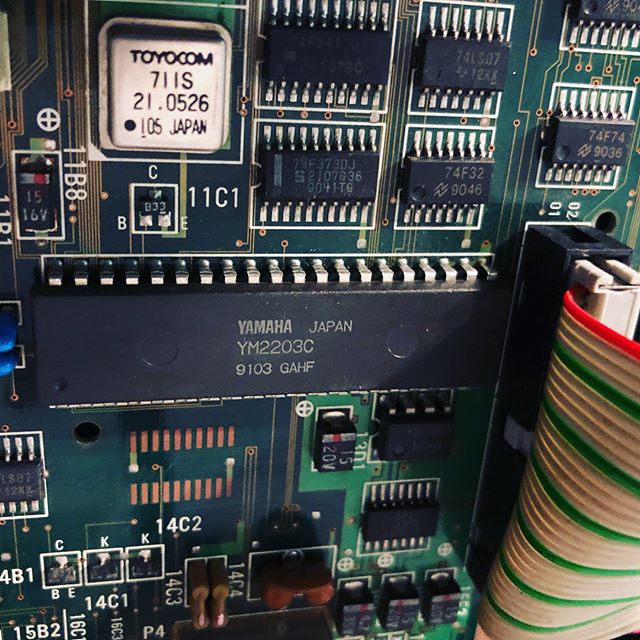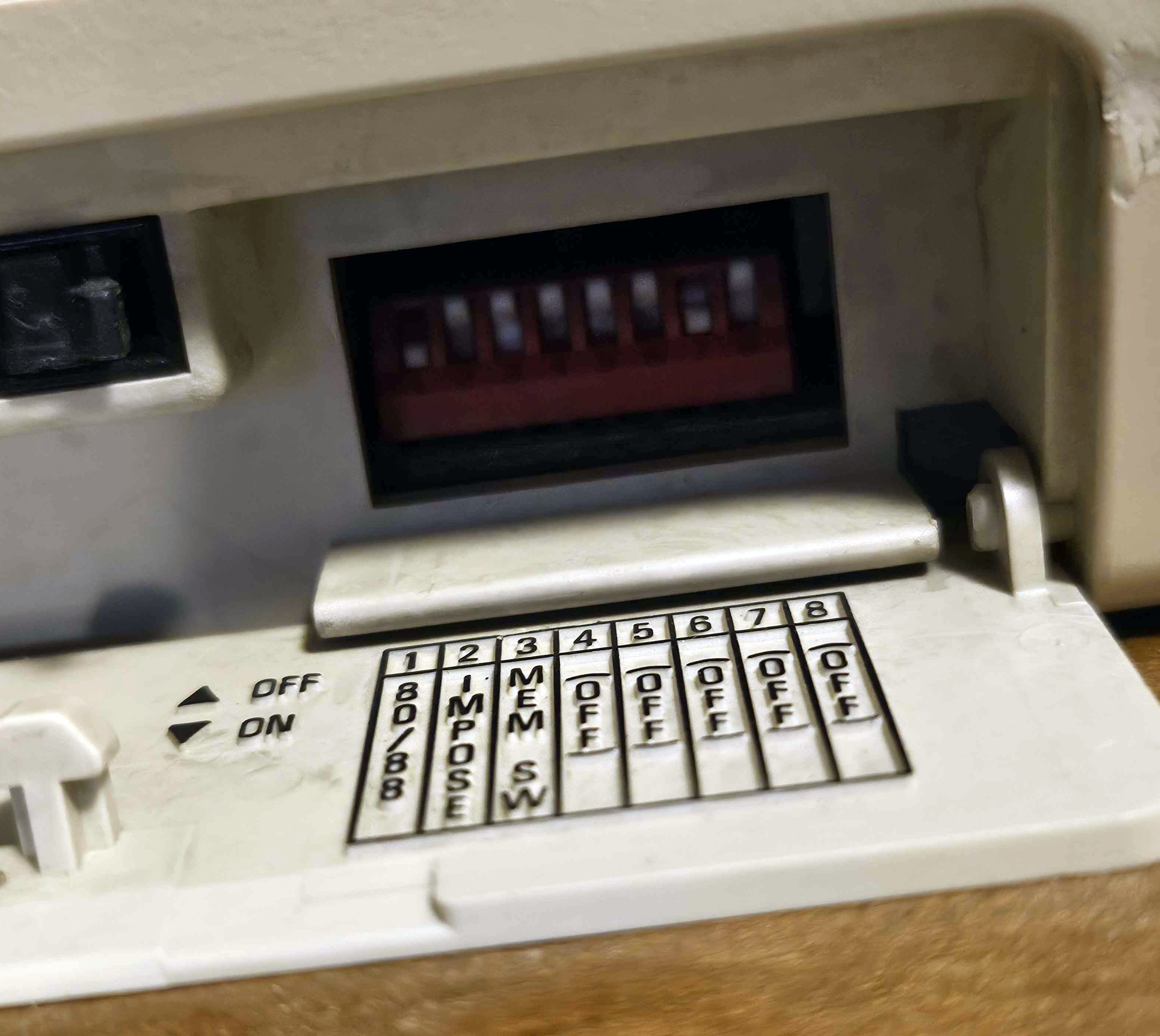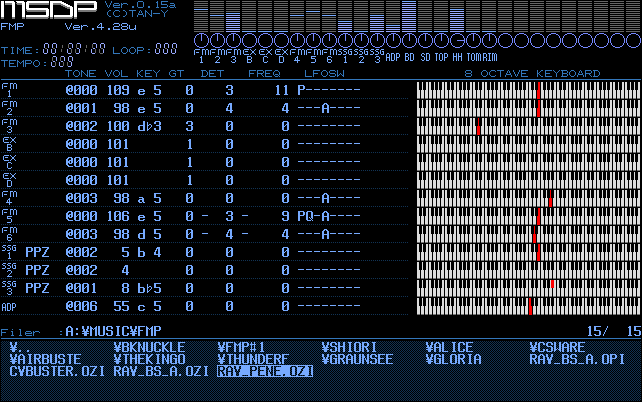
FM SYNTH!!!! YAY!!!!!!!!!! The music is like 90% of why I bought this thing. As a kid who used to think "why would anyone like Genesis music more than SNES music? it sounds like farts" but grew up into an adult who listens to the Thunder Force IV OST with the reverence and awe of someone going to church service, it was a smooth pipeline into discovering PC98 chiptune, as the sound hardware is actually very similar... the YM2612 that the Genesis uses is actually the successor to the OPN chip used in the original 9801 models, and the OPNA soundchip that later models use is basically the Genesis chip on steroids. My #1 priority when picking what model to buy was that it have some sort of FM synthesis capability, and I literally am never less elated to hear the sounds that come out of it. I love it soooooooo much.
The DA comes with onboard OPN sound that plays from its internal speaker, but isn't equipped with the fancier OPNA chip that was made famous by composers like Ryu Umemoto (YU-NO, Eve Burst Error). The OPNA has three additional sound channels over its younger brother, in addition to a six-channel ADPCM system allowing for sampled percussion. That goes a long way and allows for a significant increase in the depth and richness of sound that you can achieve.
YM2203 OPN (3 FM 3 SSG)
YM2608 OPNA (6 FM 3 SSG + ADPCM + Rhythm Sound Source)
(Grounseed is a bit of a unique case in that it has two completely different soundtracks depending on what soundboard you're using -- the OPNA version was a collaboration between Ryu Takami and Ryu Umemoto, whereas the OPN version was a collaboration between six different composers, them included. This is just one of the few tracks that happens to be the same on both OSTs.)
Both sound great, but the OPN one is clearly a much more spartan arrangement to compensate for the lost channels. I knew that I was opting for inferior hardware by electing to get a machine that only came with OPN, but personally? I don't think OPNA is that necessary at all. It came along relatively late, meaning an appreciable percentage of games on the system don't even use it at all. Most that do have two versions of the soundtrack to maintain compatibility with older hardware, and you're probably not going to know what you're missing if you're not comparing them side-by-side. I even have kind of a fondness for FM/SSG percussion.
Luckily, due to the expandability of the hardware through the C-Bus slots in the back of the machine, if I changed my mind, upgrading the sound to OPNA was a fairly simple process, though not a cheap one. The PC-9801-86 soundboard used to do this is extremely prized by collectors, which is exacerbated by the difficulty in finding one in working condition due to capacitor plague. It wasn't hard to find one for around 8000 yen back in the mid-2010s when I was first researching the 98, but in 2023 when I eventually caved and bought mine, many of them were going for twice that... But I knew that since I was interested in composing chiptune for it, I'd want one eventually, the yen was weak, and they weren't getting cheaper, so even though I didn't need one, it made sense to just grab it before it becomes unobtanium.

This is the one I ended up getting, for 16,000 yen, which was probably around a hundred bucks thanks to the exchange rate being so low... It could have been worse, but it was still more than double what I paid for the DA itself (I guess I just measure every spendy hardware purchase in PC98s now). I don't know whether it's ever been recapped, which is risky, but the seller had tested it to play music for an hour without issue and that was good enough for me.

|*′-′) .。oO(I wonder why old PC soundcards always have a joystick port? It's interesting.)
The card is plug-and-play for all intents and purposes, as drivers for it are usually included with whatever software you're using it with. If you're using a model with OPN built in, you'll have to disable it in the dip switch settings before you can use an expansion soundboard. Depending on the model, these are either literal switches on the front of the machine, software switches in the BIOS settings, or in the case of my DA, either/both! You can click here to learn more about dip switch configurations.


FM Playback with MSDP
PC98 was very popular with hobbyist composers, as the availability of drivers like PMD allowed anyone to write songs for the hardware without any sort of specialized software using the text-based markup language MML. There's a basically bottomless supply of music files floating around if you know where to look. (This archive that contains all the FMP Music Disks plus some bonuses is a great place to start.) Listening to music is one of my favorite things to do with the hardware, and I've probably spent more time using it as a jukebox than I have actually playing games.
My preferred player is MSDP (which stands for Music Selector & Displayer). It comes preloaded on YAHDI with menu commands to load the appropriate sound drivers, so if you're using that, you're already all set. If not (like if you want to load it off of a floppy) you can download it on its own. get some drivers, and manually load the one for the format you want to listen to by navigating to the folder they're in and typing PMD-ON.COM, FMP-ON.COM, etc (only one can be active at a time), and voila.
(Note: PMD files have the .M, .M2, and .MZ extensions. FMP files use .OPI, .OVI, and .OZI. Those aren't the only modules available for it, but the vast majority of stuff is in either of those two formats.)


MIDI
Many games for the system give an option whether to use FM synthesis or General MIDI for their soundtracks. Now, it might seem sacrilegous to opt for the latter when we've been spending all this time talking about how ear-meltingly glorious the system's FM sound, especially if you're used to the underwhelming default Windows wavetable synth that's made the format the butt of so many jokes, but some compositions really shine with the right hardware. Just listen to how moody and relaxing this track from Shizuku sounds on my XG module...
Can you imagine hearing this coming out of a computer back then!? Insane!? It's a little jarring to hear such high-fidelity sound paired with the pixelated graphics -- it's hard to even tell that it's sequenced music instead of prerecorded audio off a CD or something. I still think FM is better for the kind of high-energy tunes that make up most video game music, but Shizuku's OST is full of mellow, brooding compositions that you just want to zone out to, and those are really helped along by the hi-fi sampled instruments and reverb effect that a MIDI module provides.
I actually happened to have some MIDI modules sitting around already -- the cute little Yamaha XG MU15 in the above video, as well as a Roland SC-155 that's unfortunately busted and awaiting repairs -- but there's no MIDI in/out ports built into the DA, so I can't just plug it in. That's right... it's time for more expensive bespoke hardware!!


This is the Roland MPU-PC98, an interface board that provides the necessary pinouts to hook up MIDI devices. The Roland logo printed on the PCB is pretty sexy. They seem to go for 5k yen at the low end, and over 10k at the high end -- I got lucky with this one at 3.8k, which is a great price as it was confirmed working by the seller.
You don't need to use Roland hardware with it, although I did encounter glitches in certain games while using my XG module such as the percussion track playing as piano notes in the game Polestar -- probably a fault of whatever drivers the game uses rather than a quirk of the board, because other games work perfectly fine. After it's installed into the back of the rig, it's plug and play -- just connect it to your module, hook it up to a speaker, and you're good to go.
As for the module, the Sound Canvas is the gold standard, but they're not getting any cheaper or less sought after...
The PC98 has a lot of software for playing MIDIs with slick GUIs and useful playback features like volume and tempo controls, in case you want to use it as a MIDI jukebox. MIMPI seems to be a popular one -- NPLAY55 is another. My go-to is Fu-Music Player because its interface is my favorite out of the ones I've seen, and it's created with XG compatibility in mind.
A feast for the eyes AND ears!
One fun thing FUMP can do is force MIDI data to play using the internal beeper by appending /b when running the program using the DOS prompt. Yes, that thing that makes the "beep-boop" (ピポ) sound on startup. It uses arpeggios to fake the extra channels. I don't know what kind of wizardry it does to make all that happen on the fly, but here's it trying to belt out Stormy Saxophone 2 from KOF98...
Honestly, pretty impressive considering! I mean, it's got chords and everything!

Hopefully you've learned a bit about what makes the PC98 such a chiptune powerhouse! I wonder what goes into making music for the system, though?
 BACK
BACK 98 HOME
98 HOME